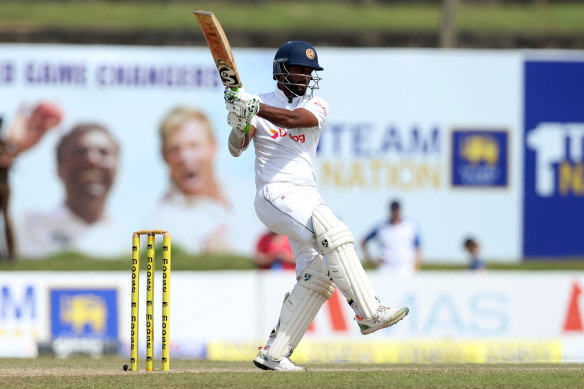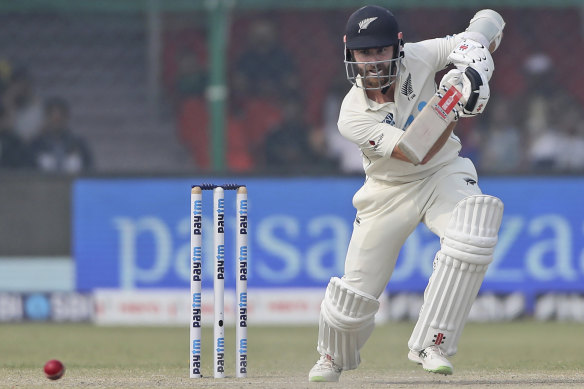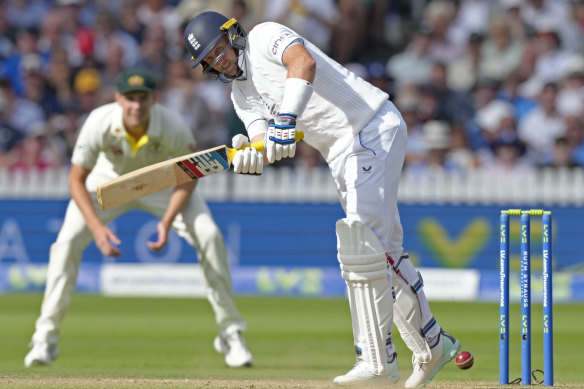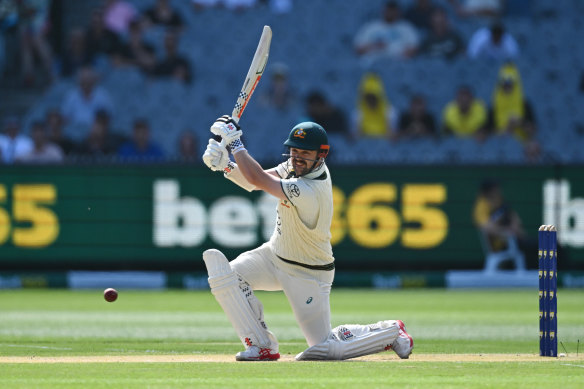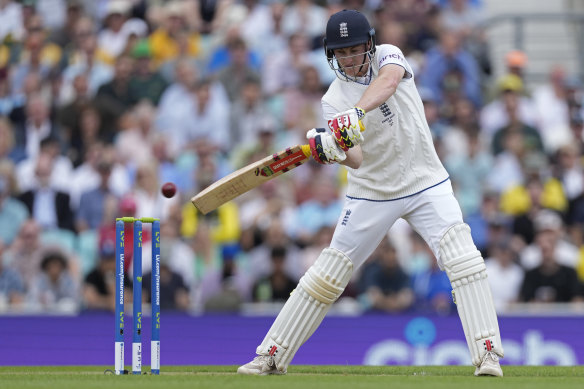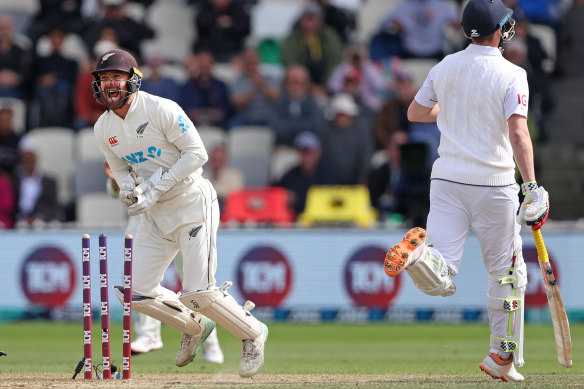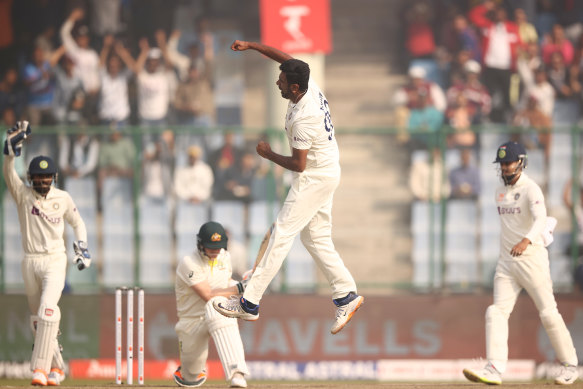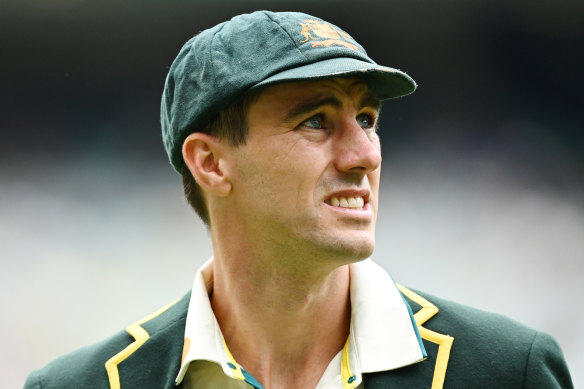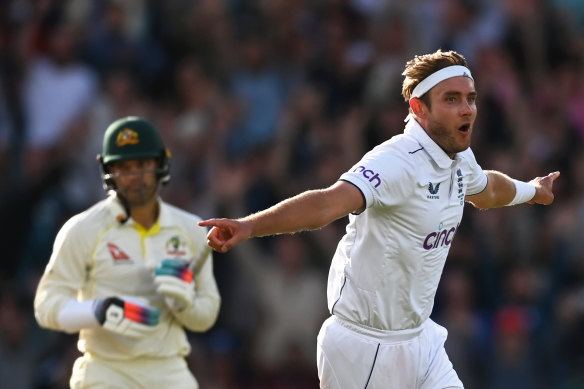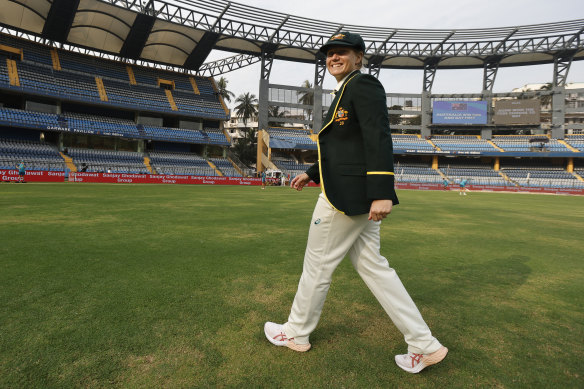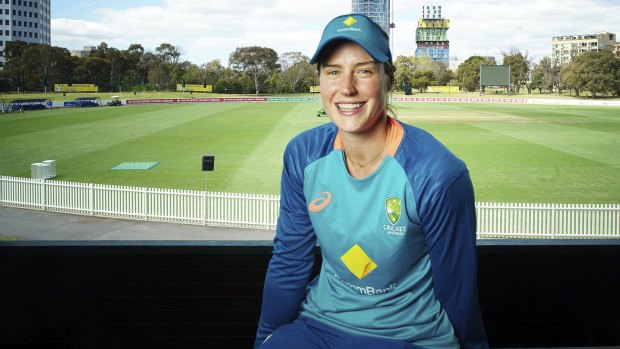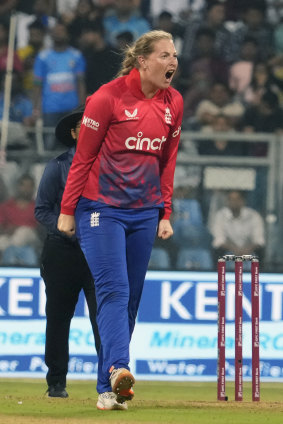After much deliberation, it was decided that Sri Lanka’s opener and Melbourne sub-districts regular should not be punished for having superior numbers against inferior opposition to his rivals. He did not play against the top four nations but an average of 52 from four digs in New Zealand showed his quality. Zak Crawley came close after coming of age in a memorable Ashes series against Australia’s vaunted attack, while his Bazball opening partner Ben Duckett was also a touch stiff.
Six Tests: 608 runs at 60.8, two centuries
Sri Lankan star Dimuth Karunaratne.Credit: Getty Images
Kane Williamson (New Zealand)
The Kiwi superstar finished the year at the top of the world batting rankings after a 2023 where he scored more centuries than any other, despite playing only seven games. Marnus Labuschagne’s underwhelming year meant there was little competition for the No.3 spot. His recovery from an anterior cruciate ligament tear after only six months is proof he is still hungry at the age of 33.
Seven Tests: 695 runs at 57.91, four centuries
Reliable Kiwi Kane Williamson.Credit: AP
Joe Root (England)
The most technically correct player in the England team, Root maintained his high standards as his side adopted a more attacking game. The former captain was a key factor in England’s resurgence to square the Ashes. Deserves the No.4 spot ahead of Steve Smith, who was a smidgen unlucky to miss the XI despite scoring 900-plus runs, including a ton in the World Test Championship final.
Eight Tests: 787 runs at 65.58, two centuries
Joe Root plays a composed shot during the Ashes series.Credit: AP
Travis Head (Australia)
The raw numbers do not tell the full story with the South Australian cult figure, who was surprisingly dropped for the start of the series in India. His 163 in the World Test Championship final was the highlight, while his unbeaten 49 made light work of a nervy run chase for a rare win in India. His ability to take the game away from the opposition has made him a prized wicket.
12 Tests: 919 runs at 41.77, one century
Travis Head’s standout 2023 still only included the one Test century.Credit: Getty Images
Harry Brook (England)
Ideally, we’d be picking either an all-rounder or a dynamic wicketkeeeper/batter at six and seven. With Ben Stokes not bowling, Mitch Marsh not taking enough wickets and Ravindra Jadeja not scoring enough runs, there was no viable all-round option. The lack of a prolific-scoring gloveman also stymied us. Instead, we settled on a specialist batter and the next in line was Brook, arguably the world’s finest young willow wielder, based on his stellar Ashes form, but we reserve the right to make a change depending on conditions.
Eight Tests: 701 runs at 53.92, one century
Dashing play: Harry Brook on the offensive during the Ashes series.Credit: AP
Tom Blundell (New Zealand)
This was the most difficult position in the side to pick. Alex Carey was the best with the gloves but his batting became a concern. Jonny Bairstow had the best numbers but his misses behind the pegs cost England the urn. In New Zealand’s Tom Blundell, we’ve found the middle ground, though his form with the bat fell away alarmingly after an excellent start to the year at home against England.
Seven Tests: 433 runs at 36.08, one century, 22 catches, seven stumpings
Got him: New Zealand’s Tom Blundell runs out Harry Brook.Credit: Getty Images
Ravichandran Ashwin (India)
In another tough call, I’ve settled on India’s off-spinning wizard as this team’s twirler, just ahead of Ravindra Jadeja and Nathan Lyon. Ashwin pipped Lyon as he had a better Border-Gavaskar series, and, as mentioned above, there was plenty of thought given to playing Jadeja at seven as the second spinner. Jadeja comes in for Brook to bat at seven if spin-friendly conditions prevail.
Seven Tests: 41 wickets at 17.02, four five-wicket hauls
Ravi Ashwin gets the prized wicket of Steve Smith in Delhi in February.Credit: Getty Images
Pat Cummins (c) (Australia)
A banner year on the field for Cummins finishes with 10 wickets in the Boxing Day Test and undoubtedly the most prestigious honour of all – the captaincy in our XI. The pace ace was instrumental, with bat and ball, in setting up Australia’s 2-0 Ashes lead and though he faded late in an arduous campaign, he rediscovered his best back home to finish 2023 on high. Though he appeared rattled at times by England’s frantic scoring, Cummins can point to his stewardship of the team in the World Cup final to silence critics of his captaincy. He remains the world’s preeminent fast bowler.
11 Tests: 42 wickets at 27.50, three five-wicket hauls
Australia’s Test captain Pat Cummins.Credit: Getty Images
Kagiso Rabada (South Africa)
South Africa play so little Test cricket these days it’s easy to forget how good Rabada is, but he gave us a timely reminder of his skills in the last week of the year, leading the Proteas to an innings victory over India with seven wickets. Though others played more, Rabada’s 20 wickets at 17, and a strike rate of a wicket every 33 balls, could not be ignored. Apologies to Mitchell Starc, who was Australia’s most consistent quick in the Ashes but narrowly misses out here.
Four Tests: 20 wickets at 17.10, two five-wicket hauls
South African quick Kagiso Rabada finished 2023 with a bang.Credit: Getty Images
Stuart Broad (England)
The man Australian cricket fans love to hate bows out having never lost an Ashes series at home. Though his partner in crime James Anderson showed signs of age, Broad was a constant threat to Australia, invariably striking when called upon. His fairytale finish will go down in cricket folklore, though his dropped chance at Edgbaston could have changed the course of the series.
Eight Tests: 38 wickets at 26.28, one five-wicket haul
Test cricket mainstay: England’s Stuart Broad.Credit: Getty Images
Women’s Team of the Year
The evolution of Ellyse Perry as a cricketer has been recognised with selection in this masthead’s team of the year.
Ideally, we would be picking a women’s Test team of the year but with only three games played in the format this we have instead settled on a white-ball side selected to play in both the 50-over and 20-over arenas.
Loading
One of five Australians in the XI, Perry has been rewarded for reinvigorating her T20 batting, which has shone in the top order at domestic level and in the middle for her country.
By adding power to her game, Perry has again become an automatic selection for Australia despite her bowling not having the bite it once had.
Perry was one of the first picked in this side, along with other golden generation members Beth Mooney and Ash Gardner, and internationals Nat Sciver-Brunt, Amelia Kerr and Sophie Ecclestone.
Our commitment to staying as faithful as we could to players’ roles for their country created headaches at the top of the order, where there was plenty of competition, number six and two seam-bowling berths, where there was not as much depth.
Alyssa Healy’s ability to play dual roles – and her strong form in the major tournament of the year – edged her ahead of Hayley Matthews, Kiwi run machine Suzie Bates, South Africa star Laura Wolvaardt and Sri Lanka ace Chamari Athapaththu.
All can consider themselves extremely unlucky not to be opening, though in all-rounder Matthews’ case her bowling alone was enough to get her a place lower down the order.
Beth Mooney (Australia)
One of the world’s most dependable batters, Mooney beats a high-class field for one of the openers’ berths. Her excellent international form in the 50-over and 20-over arenas combined with another excellent WBBL campaign made her impossible to overlook at the top of the order.
ODI: 429 runs at 71.5, strike rate: 91.3; T20: 410 at 41, 120.6
Alyssa Healy (c) (Australia)
Australia’s new captain gets the nod to partner Mooney. Just. Though Healy missed almost the entire WBBL, her strong WPL on top of an excellent T20 World Cup, the major tournament in the year, and her dual playing role as a wicketkeeper got her over the line to open over Hayley Matthews and Laura Wolvaardt.
ODI: 122 runs at 20.33, 103.4; T20: 321 at 32.1, 133.75
Alyssa Healy became Australia’s new women’s captain in 2023.Credit: Getty Images
Amelia Kerr (New Zealand)
The gun New Zealander may have struggled to get into a T20 team of the year with her strike rate but her excellence in the 50-over format at No.3 wins her a ticket in our hybrid conditions, just ahead of Sri Lanka’s Chamari Athapaththu, who is a natural opener. Her leg-spin adds depth to the attack.
ODI: 541 runs at 67.6, 87.7; T20: 365 at 36.5, 115.5
Nat Sciver-Brunt (England)
The Englishwoman was one of the first picked after dominant performances in the T20 World Cup and WPL. Her country’s player of the year, Sciver-Brunt’s heroics with the bat were a major reason why England fought their way back to square the Ashes. A knee injury reduced her bowling workload but she commands a spot on batting alone.
ODI: 393 runs at 131, 107.37, T20: 364 at 45.5. 135.8
Ellyse Perry (Australia)
The player of her generation, Perry has learned new tricks in her early 30s, lifting her scoring rate to regain a place in the middle order in Australia’s T20 side. Her strike rate of 162 stands her well above others batting at five to seven in the format at international level. She remains a force in the longer forms.
ODI: 417 runs at 69.5, 89.5; T20: 319 at 45.6, 151.2
Ellyse Perry is the player of her generation.Credit: Luis Enrique Ascui
Marizanne Kapp (South Africa)
At face value, and on her T20 record, the South African is a touch lucky to get into this side but we’ve found a place for her based on the heavy ODI runs she’s scored in the middle order: no player has scored more at numbers five, six or seven.
ODI: 300 runs at 75, 88.5, six wickets at 35.8, 3.98 runs per over; T20: 177 at 22.1, 118; 11 wickets at 23, 6.27 rpo
Hayley Matthews (West Indies)
The West Indies star gets a run in our team after a stunning T20 series against Australia at the start of the local international season. Unlucky not to be opening the batting, Matthews’ bowling is good enough on its own to command a spot in the side. Matthews at No.7 is a frightening proposition.
ODI: 156 at 39, 98.7, five wickets at 16, 3.47 rpo; T20: 700 at 63.6, 132.3; 19 wickets at 16.2, 6.84 rpo
Ash Gardner (Australia)
With her big hitting and nerveless off-spin, Gardner is one of the most valuable players in the world, as evidenced by her $558,000 price tag in this year’s inaugural WPL auction. Though 2023 was not her best year, Gardner still finished it as the leading wicket-taker in ODIs. Her best performance came with a player of the match gong in the T20 World Cup semi-final.
England’s Sophie Ecclestone reacts after taking a key wicket against India during their Twenty20 series.Credit: AP
ODI: 186 at 37.2, 123.2, 23 wickets at 15.1, 4.15 rpo; T20: 234 at 29.3, 121.2; 17 wickets at 19.7, 7.33 rpo
Sophie Ecclestone (England)
The game’s premier spinner is a central figure in an attack full of quality slow-bowling options. The left-armer followed a stellar T20 World Cup with important Ashes contributions. She is a key pillar in England’s future for many years to come.
ODI: Five wickets at 23.8, 4.4 rpo; T20: 23 wickets at 10.6, 5.65 rpo
Lea Tahuhu (New Zealand)
In a team that struggled, the Kiwi seamer could not have done much more to win more games for her country. Her selection is also an indication of the lack of consistent performances by international seamers, some of whom – like Australian Darcie Brown and South Africa’s Shabnim Ismail – had strong T20 World Cups but could not back it up.
ODI: 15 wickets at 20.86, 4.71 rpo; T20: 14 wickets at 13.51, 6.51 rpo
Megan Schutt (Australia)
The veteran’s numbers in Australia’s T20 World Cup defence, combined with her performances in the WBBL were enough to get her in the XI, despite her lack of potency in the 50-over format.
ODI: Four wickets at 66, 4.71 rpo; T20: 21 wickets at 15.57, 6.81 rpo
*Women’s statistics up until India v Australia on December 30.
News, results and expert analysis from the weekend of sport sent every Monday. Sign up for our Sport newsletter.
>>> Read full article>>>
Copyright for syndicated content belongs to the linked Source : Brisbane Times – https://www.brisbanetimes.com.au/sport/cricket/australia-s-all-conquering-skipper-and-the-player-of-her-generation-the-stars-of-our-top-xis-for-2023-20231213-p5er8v.html?ref=rss&utm_medium=rss&utm_source=rss_feed




















